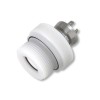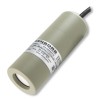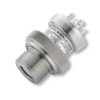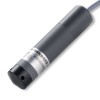Flush diaphragm level sensors constructed from chemically resistant plastics and featuring flush ceramic diaphragms offer reliable level measurement in challenging applications involving corrosive liquids where metal contact must be avoided. These sensors are designed to withstand aggressive chemicals while providing accurate and stable level readings, ensuring process integrity and preventing contamination.
 Viscous machine tool coolant level measurement with flush diaphragm sensor - Using a flush ceramic diaphragm to prevent clogging in viscous machine tool coolant tanks, ensuring reliable level measurement for oil and water emulsions containing swarf.
Viscous machine tool coolant level measurement with flush diaphragm sensor - Using a flush ceramic diaphragm to prevent clogging in viscous machine tool coolant tanks, ensuring reliable level measurement for oil and water emulsions containing swarf.
 LMK351 High Overpressure Flush Level Transmitter
LMK351 High Overpressure Flush Level Transmitter LMK809 Plastic Submersible Low Level Transmitter
LMK809 Plastic Submersible Low Level Transmitter LMK331 Screw-In Ceramic Level Transmitter
LMK331 Screw-In Ceramic Level Transmitter LMK807 Plastic Submersible Level Transmitter
LMK807 Plastic Submersible Level Transmitter
Find out more about Corrosive Chemical Compatible Flush Diaphragm Liquid Level Sensors to determine which product options and capabilities will best meet your application requirements.
Flush diaphragm level sensors with chemical-resistant plastic bodies are essential for level measurement in applications involving corrosive liquids. These specialized sensors address the challenges posed by aggressive chemicals that can damage traditional level sensing technologies or contaminate the process media.
Key Features
- Chemical Compatibility: The sensor’s construction from chemically resistant plastics, such as PTFE, PVDF, or PP, ensures compatibility with a wide range of corrosive liquids, including acids, bases, and solvents. This prevents sensor degradation and maintains measurement accuracy even in harsh environments.
- Flush Ceramic Diaphragm: The flush ceramic diaphragm provides a smooth, non-intrusive sensing surface that minimizes media buildup and prevents clogging. This ensures reliable level measurement and reduces maintenance requirements.
- No Exposed Metal Parts: The sensor design eliminates any exposed metal parts, preventing contact between the corrosive liquid and metal components. This eliminates the risk of corrosion, contamination, and sensor failure.
- Wide Application Range: These sensors are suitable for various applications, including chemical processing, pharmaceutical manufacturing, wastewater treatment, and food and beverage production. They can be used in tanks, vessels, and pipelines containing corrosive liquids.
- Versatile Mounting Options: The sensors offer versatile mounting options, including threaded connections, flange mounts, and sanitary connections, allowing for easy installation in different process setups.
Applications
- Chemical Storage Tanks: Monitoring the level of corrosive acids, bases, or solvents in storage tanks to prevent overfilling, ensure safe handling, and optimize inventory management.
- Chemical Reactors: Measuring the level of reactants or products in chemical reactors involving corrosive chemicals to control reaction rates, prevent spills, and ensure process safety.
- Wastewater Treatment: Monitoring the level of corrosive wastewater in treatment plants to control flow rates, prevent overflows, and ensure efficient treatment processes.
- Pharmaceutical Manufacturing: Measuring the level of corrosive chemicals or intermediates in pharmaceutical production processes to maintain product quality, prevent contamination, and ensure process consistency.
- Food and Beverage Processing: Monitoring the level of acidic or alkaline cleaning solutions in food and beverage processing to ensure proper sanitation and prevent product contamination.
